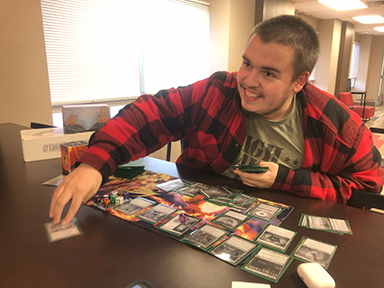By DERRICK GALINDO
Senior Reporter

A test run, a massacre, a card game.
A single game of Commander, a way to play a game of Magic: The Gathering. A simple table serving as their battleground. A set of printed cards, sleeved in green card protectors, a proxy deck, owned by Zayne Hunter, a sophomore computer science major from Woodward; and his opponent, Dawson DeFoor, a freshman speech and theater major from Erick.
Hunter, who wanted to test out a blue element counter themed deck, rapidly set up cards during his turn, leaving the field open for DeFoor to think and make moves. DeFoor, using an incomplete landfall deck, placed a land card and ended their turn. Hunter, after drawing, counters the card placed by his opponent, and starts accumulating points to his commander and ends his turn.
DeFoor attempts to pivot after losing their card to a counter spell. Placing a new card in the playing field and ending their phase. Hunter, after drawing, countered the card placed by DeFoor. His commander gained more strength. This tango continued for many turns, before Hunter decided to up the ante.
One, he played a card to remove the traditional rule of seven cards in a player’s hand for himself; two, he set up “telepathy.” He knows DeFoor’s hand for the rest of the game; three, he does a favor for DeFoor after he complained about his current hand, and resets the cards in both players’ hands.
Between these plays by Hunter, DeFoor attempted to recover by placing cards, but Hunter countered back with the ample number of cards in his hand and placed more points on his commanding card. At this point, the card was covered in dice, serving as a reminder to the number of points, and Hunter had a hand size of 18 cards.
This led to Hunter’s final set of moves before victory. He reset the players’ hands, redrawing to his hand size, doubling it and drawing an extra set of cards based on his commander’s energy.
Placing one last card, ending the game in Hunter’s victory, despite no damage taken by either side. He was holding nearly his entire draw pile – almost 80 cards – in his hand which satisfied the conditions of the card. Hunter said he planned on making this counter deck in order to counter the more skilled players in his group of Magic: The Gathering players, and he was satisfied with testing it out.
